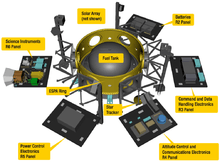EELV Secondary Payload Adapter
The EELV Secondary Payload Adapter (ESPA) is a payload adapter ring for launching secondary payloads on EELV-class orbital launch vehicles.
Originally developed in the 2000s to launch secondary payloads on US DoD space missions that use the Atlas V and Delta IV Evolved Expendable Launch Vehicles (EELV), the adapter design has become a de facto standard and is now also used for some private spacecraft missions as well. For example, multiple ESPA rings were used on a non-DoD launch of the SpaceX Falcon 9 that carried the Orbcomm OG-2 constellation of communication satellites.
The use of ESPA technology reduces launch costs for the primary mission and enables secondary and even tertiary missions with minimal impact to the original mission.
History
Development was funded by the Air Force Research Laboratory Space Vehicles Directorate (AFRL/VS) for the United States Department of Defense (DoD) Space Test Program (STP) under a Small Business Innovative Research (SBIR) grant in the late 1990s. Moog CSA Engineering teamed with AFRL to design, build and qualify the ring in the early 2000s.[1] Additional studies have been done on ESPA applications for lunar and science missions under an SBIR from NASA Ames Research Center [2] As of 2010, the ring is produced by Moog CSA Engineering.[3]
As of December 2015, the ESPA ring had been used on all 3 EELV rockets (Atlas V, Delta IV and Falcon 9).[4][5][6]
Multiple ESPA rings may be used on a single launch, stacked to increase the satellite carrying capacity. Two ESPA Grande rings were used on Orbcomm OG-2 flight 1 in 2014 and three stacked Grande rings for the 11-satellite Orbcomm OG-2 flight 2 deployment in 2015.[7]
Technical characteristics
The initial ESPA ring was designed to support a 15,000-pound (6,800 kg) primary payload and up to six 400-pound (180 kg) secondary payloads. Each secondary spacecraft is mounted radially on a 15 inches (380 mm) diameter port and is allocated 24 inches (610 mm) × 28 inches (710 mm) × 38 inches (970 mm) volume. This has led to the colloquial designation of ESPA-class payloads. The design includes a standard electrical interface for the attached payloads; however mission-specific requirements may preclude each secondary payload from receiving more than a single, non-redundant payload separation signal.[2]
Notable missions

A number of missions have used the ESPA ring. The ESPA ring’s maiden mission was on STP-1 in 2007.[1] When NASA upgraded its Lunar Reconnaissance Orbiter (LRO) mission’s launch vehicle to an Atlas V, it freed around 2,200 lbs. of additional mass for what would later become the Lunar Crater Observation and Sensing Satellite (LCROSS). NASA held a competition to see how best to use the space and a number of proposals came from the Ames Research Center. The winning proposal included Moog CSA Engineering’s ESPA ring serving as the base mechanical satellite bus to launch the LCROSS spacecraft as a secondary payload under the LRO. LCROSS ultimately impacted the lunar surface and confirmed the presence of water ice.[1]
The LCROSS Lunar-impact water detection mission in 2009 took advantage of the structural capabilities of ESPA ring to attach all six of its science experiments, command and control systems, communications equipment, batteries, solar panels, and even a small monopropellant propulsion system to implement pre-impact payload separation and control.[8]
Derivatives
Commercial derivatives of the ESPA Grande ring include the Spaceflight Secondary Payload System (SSPS) and SHERPA developed and manufactured by Andrews Space under contract to Spaceflight Services. SSPS includes five 24 inches (61 cm)-diameter ports, each capable of carrying payloads weighing up 300 kilograms (660 lb). "The SSPS operates very similar to a standalone spacecraft with a flight computer, electrical power system, orbit determination capability, and payload power switching."[9] SHERPA is a powered variant of SSPS capable of large orbit change.[10]
References
- 1 2 3 Perry, Bill. "ESPA: An Inexpensive Ride to Space for Secondary Payloads". July 2012 Edition of MilsatMagazine. Retrieved 26 September 2012.
- 1 2 "Evolved expendable launch vehicle secondary payload adapter" (PDF). AIAA. Retrieved 2011-08-10.
- ↑ "ESPA: The EELV Secondary Payload Adapter Heavy Lift. Excess Capacity. Small Satellites". MOOG. 2010. Retrieved 2011-12-25.
- ↑ United Launch Alliance Successfully Launches First USAF Atlas V
- ↑ ULA Delta IV AFSPC-4 mission
- ↑ SpaceX’s Falcon 9 finally launches Orbcomm OG2 mission
- ↑ "ORBCOMM OG2 Next-Generation Satellite Constellation". Sierra Nevada Corporation. Retrieved 2016-01-04.
- ↑ Lo, Amy (2009). "Secondary Payloads Using the LCROSS Architecture" (PDF). AIAA. Retrieved 2011-09-27.
- ↑ Spaceflight Secondary Payload System Archived 2012-07-07 at Archive.is, retrieved 2012-05-10.
- ↑ Jason Andrews. "Spaceflight Secondary Payload System (SSPS) and SHERPA Tug - A New Business Model for Secondary and Hosted Payloads".
External links
- Triple ESPA ring for SpaceX Orbcomm OG-2 launch, October 2015.